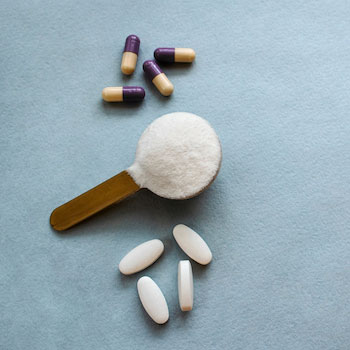Dietary supplements containing so-called “peptide hormones” (sometimes called “peptides”) are marketed for a variety of benefits, including muscle growth, weight loss, and even anti-aging. Do they actually contain peptide hormones? And are they safe to use?
Peptide hormones can cause serious health risks and are prohibited for use by Service Members.
What are peptide hormones?
They are hormones produced by the body and made of amino acids (from less than 10 to a few hundred). They circulate in the blood, where they have various specific functions. Examples of peptide hormones produced in the body include erythropoietin (EPO), human growth hormone (hGH or HGH), growth hormone–releasing peptides (GHRP), human chorionic gonadotrophic hormone (commonly known as hCG or hCGH), insulin, and insulin-like growth factor (including IGF-1). Many are also produced synthetically (in a laboratory) for use in prescription (and experimental) drugs to treat various disorders and diseases.
Why are they a dietary supplement problem?
The misuse of peptide hormones can cause serious health problems. The peptide hormones mentioned above are for medical use by prescription only. They are not appropriate for use in in any dietary supplements. The World Anti-Doping Agency (WADA) prohibits the use of all peptide hormones.
Advertising of dietary supplements associated with peptide hormones can be confusing and misleading. Marketing language might suggest that a product contains a peptide hormone, or the name of a product might even include the name of a peptide hormone, but examination of the product’s Supplement Facts panel often reveals no peptide hormone in the list of ingredients.
In most cases, orally consumed peptide hormones aren’t likely to enter your bloodstream. Your body typically breaks down a peptide hormone into individual amino acids during digestion. However, some drug companies are developing peptide hormones for effective oral delivery as therapeutic agents. Also, some companies market products to be taken buccally (through the cheek membranes inside the mouth) or sublingually (under the tongue), which should help avoid digestive breakdown, but such products also are not considered dietary supplements. The same goes for transdermal (skin) patches, skin creams, and injectables. Dietary supplements must be consumed orally.
Synthetic peptide hormones are distributed on the black market and are often misused by athletes due to their performance-enhancing effects. Synthetic peptides such as sermorelin and ipamorelin are promoted for anti-aging (smoothing wrinkles), muscle-building, fat loss, and sexual vitality. In many cases peptides sold online are advertised as “not for human consumption” or “for research purposes only,” even though they clearly are marketed to bodybuilders and other athletes or for weight loss. In addition, neither the purity nor the potency of such products can be ensured.
The bottom line
In short, peptide hormones—sometimes sold as dietary supplements or in other forms without a prescription—are not safe or legal. Each peptide hormone poses specific, serious health risks, so they should only be used under the supervision of a qualified healthcare provider. They also can be a threat to your military career. Peptide hormones are on the DoD Prohibited Dietary Supplement Ingredients list, so Service Members should avoid products with these ingredients.
Updated 07 March 2022

